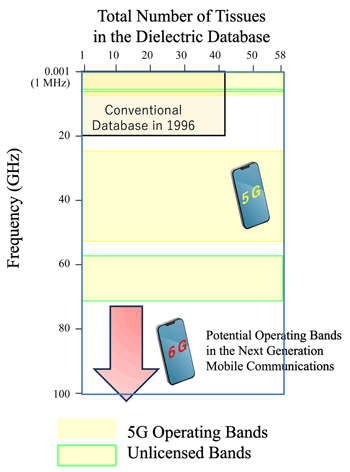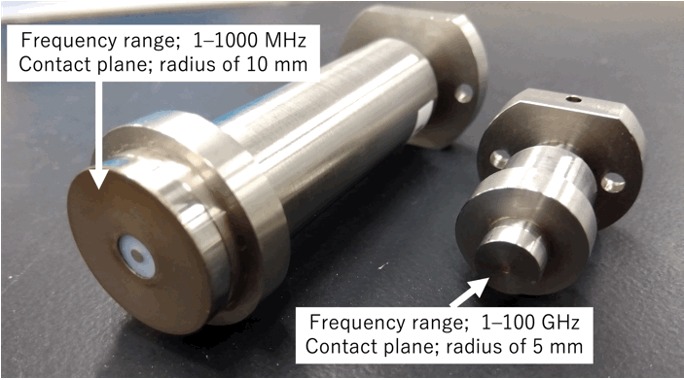Abstract
The National Institute of Information and Communications Technology (NICT, President: TOKUDA Hideyuki, Ph.D.) released an open-source database of tissue dielectric properties on March 30, 2023. This database was constructed using the datasets of 58 types of tissue in the frequency range from 1 MHz to 100 GHz. This database includes many of the novel measurement data particularly those obtained above 20 GHz, which include operating frequency bands of 5G systems.
By releasing this database, we will contribute to the safe and secure use and dissemination of radio wave utilization technology for 5G era through its use for numerical simulations in the evaluation of human safety of 5G systems and the development of medical and healthcare device technologies.
"Database of Tissue Dielectric Properties for Electromagnetic Modeling of Human Body"
Background

Figure 1 World's largest database of dielectric properties for biological tissues (blue frame).
A list of relative permittivity, dielectric loss, and electrical conductivity according to frequency (CSV file) is available for download.
A list of relative permittivity, dielectric loss, and electrical conductivity according to frequency (CSV file) is available for download.
With the rapid progress of wireless communication technology, radio waves are being used in various forms in our daily lives. The 5G system that uses operating bands in the frequency range from 24.5 to 52.6 GHz, a frequency range higher than that of conventional mobile phone systems, has been put to practical use, and even higher frequencies are expected to be used in the future. NICT has been developing technologies such as numerical human body models to simulate human exposure (e.g., energy absorption) by a computational approach when the human body is exposed to radio waves from wireless products, such as 5G systems and other wireless communication technologies, for radio protection from excessive exposure.
The behavior of radio waves penetration inside the human body is determined by dielectric properties that vary depending on the tissue and frequency. However, owing to limited number of tissue dielectric data, human exposure levels at frequencies above 20 GHz have been simulated using tissue dielectric properties estimated from measurement data at lower frequencies.
Outline of database of tissue dielectric properties
NICT has been developing measurement technology for tissue dielectric properties since 2011. Using our technology, the dielectric properties of 58 types of tissue were measured in the frequency range from 1 MHz (1/1000 GHz) to 100 GHz and released on a web page. The number of types of tissue that make up this database is the largest in the world (see Figure 1; approximately 40 types of biological tissues make up the conventional database).
It is also the only database in the world that includes the dielectric properties of biological tissues measured in the frequency band above 20 GHz. With regard to human exposure to radio waves, the results obtained using this database have been cited as the most reliable and adopted as a rationale for the exposure limits in the international guidelines of human protection from radio wave exposure.
Future prospects
By combining this database with a numerical human body model, it is possible to accurately simulate human exposure to radio waves in the operating frequency bands in 5G systems and the other frequencies used in the latest wireless communication systems. Furthermore, this database is available for the development of medical and healthcare devices that use radio waves.
In the future, we will conduct research and development to expand the database to 1,000 GHz (1 THz) to accommodate next-generation mobile communication systems called Beyond 5G and 6G.
Open source database
The database of tissue dielectric properties has been available since March 30, 2023. Anyone can use the database, but please read the Terms of Use before using it.
Part of this work was supported by the Ministry of Internal Affairs and Communications Grant Number JPMI10001.

 nict.go.jp
nict.go.jp